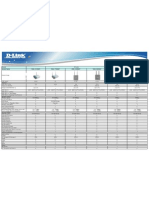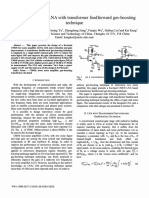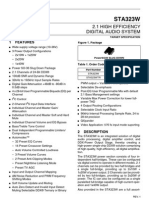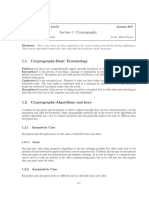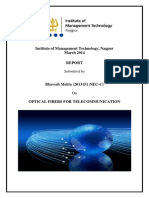BalunTesting 0
BalunTesting 0
Uploaded by
Tara KimCopyright:
Available Formats
BalunTesting 0
BalunTesting 0
Uploaded by
Tara KimOriginal Title
Copyright
Available Formats
Share this document
Did you find this document useful?
Is this content inappropriate?
Copyright:
Available Formats
BalunTesting 0
BalunTesting 0
Uploaded by
Tara KimCopyright:
Available Formats
Measurement techniques for Baluns
May 6, 2005
Measurements techniques for baluns
A balun consists of an unbalanced port and two balanced ports. The balun is a passive and
reversible device. Therefore the unbalanced port can be used as either an input or an output;
likewise the balanced ports can be used as inputs or outputs.
Baluns are also frequently used as impedance-transforming devices. For historical reasons the
most commonly used impedances of the unbalanced ports are 50 or 75 Ohms and simple
transformation ratios of 1:1, 1:2, and 1:4 are widely used. This creates components with
impedances in the ranges of 50:50, 50:100 and 50:200 Ohms for 50 Ohm system impedance and
75:75, 75:150 and 75:300 Ohms for 75 Ohm system impedances.
This document discusses some of the issues involving evaluating the performance of general
baluns on different types of equipment. The techniques and pitfalls identified are general for all
types of baluns and not just for the stripline version described here. There are two basic frequency
domain methods and one time-domain method.
The first section describes the preferred method, which enables the user to get full S-parameters of
the entire balun. This allows the user to gain significant insight into the performance of all aspects
of the balun. Most of the same results can be obtained using the other approaches.
2-ports analyzer techniques
Using a 2-port analyzer to evaluate the performance of a 3-port device involves some switching of
cables and performing multiple measurements to gather enough information to perform the
calculation to evaluate the true balanced performance.
In the following section the unbalanced port is labeled P1 and the corresponding return loss is
labeled S11 , consequently return loss measured on the two balanced ports ( P2 and P3 ) are
labeled S 22 and S33 . Furthermore the logical balanced port is labeled PD2 and its corresponding
return loss is labeled SD22 .
Return loss measurements using 2-port analyzers
Terminating the balanced ports with the correct loads and performing a straightforward return
loss measurement on the unbalanced port one can evaluate the unbalanced return loss.
Evaluating the performance of the balanced port requires several measurements and some
transformation of single ended S-parameters into balanced. The following equation describes the
relationship between the single ended measurements and the balance port measurements.
SD22 = 20 Log10
1
1
2
2
2
2
S 22 + S 33 - S 23 + S 32
2
2
) (
Equation 1
Equation 1 transforms the 2 sets of single ended return loss measurements combined with insertion
loss measurements into balanced port impedance. Complex values of all the S-parameters must be
Page 1 of 11
USA/Canada:
Toll Free:
Europe:
(315) 432-8909
(800) 411-6596
+44 2392-232392
Measurement techniques for Baluns
May 6, 2005
used to make the equation valid, and is to be used with data that has been deembedded and
renormalized to the goal impedances.
Due to the way the baluns works (any balun, both Flux coupled and stripline version) one will find
6 dB worth of return loss measured singled ended onto either port 2 or port 3 of any balun.
Figure 1 (left) Return loss of balun measured as a 3 ports device. (right) Return loss of balun
measured as logical 2-port device.
Figure 1 shows the return loss of a typical balun depicted in both single ended and differential
modes. Combining the measurements of S 22 and S33 from Figure 1(left) with measurements of
S 23 and S32 using Equation 1 the differential mode return loss will be as shown in Figure 1(right)
Phase and amplitude measurements using a 2-port analyzer
To evaluate the phase and amplitude balance of a balun it is important to note that the system, in
which it is measured, must be repeatable to within the tolerance of which the measurements are
required.
So if a mechanical switch is employed to connect between the two differential ports and the
analyzer it has to be repeatable enough not perturb the results. Likewise, if a simple approach of
manually unhooking and re-hooking coaxial lines, good RF-measurements techniques should be
followed.
Amplitude and phase balance is evaluated using the following equation:
AB = 20 Log10
S 31
S 21
Equation 2
S
PB = ang 31
Equation 3
S 21
It should be noted that if the parameters are used in the reverse order the results are still correct,
but the balance will have an opposite sign. However, in most case the user is only interested in the
absolute value and therefore the sign is of no importance.
USA/Canada:
Toll Free:
Europe:
(315) 432-8909
(800) 411-6596
+44 2392-232392
Page 2 of 11
Measurement techniques for Baluns
May 6, 2005
Back-to-Back measurements
This technique involves mounting two identical units in a Back-to-Back configuration. This
enables the user to evaluate the insertion loss of both units in series and calculate the loss by
dividing the results by 2. The drawback in evaluating the insertion loss of baluns in this manor is
that balun #1 is used to match into balun #2 and assuming good production tolerances the result
will become too good.
More representative insertion loss measurements are based on adding the measurements of S21
and S31 after each of the measurements have been deembedded and renormalized to the target
impedances.
IL power = 20 Log10 S12 + S13
Equation 4
Equation 4 is used to determine the insertion loss of a balun. Equation 4 only looks at the
transmitted energy and therefore the insertion loss due to miss-matched ports is accounted for.
However Equation 4 does not take into account insertion loss due to non-ideal phase and
amplitude balance of the device, it evaluates the transmitted power from input of the balun to the 2
balanced outputs. This approach does not tell how well the energy got transformed into a balanced
signal. However Equation 8(a-d) part (a) takes phase and amplitude into account.
IL1d = 20 log10 S1d = 20 log10
1
2
(S12 - S13 )
Equation 5
190
-0.2
188
-0.4
186
-0.6
184
Phase Balance (Baluns M odel:2425B50-50 Job:MSAM PLE)
Phase Balance [deg]
]
B
d[
s
s
o
L
n
oi
rt
e
s
nI
Unsorted Insertion Loss (Baluns Model:2425B50-50 Job:MSAMPLE) (Total Parts 1)
0
-0.8
-1
-1.2
182
180
178
-1.4
176
-1.6
174
-1.8
172
-2
1000
1500
2000
2500
Freq [GHz]
3000
3500
170
1000
1500
2000
2500
Freq [GHz]
3000
3500
Figure 2 (left) Shows the insertion loss difference for a balun measured using the power
approach (blue) versus the balanced approach (green). Note that the balanced approach will
asymptotically approach that power approach, but never exceed. (right) Iindicates the phase
performance of the unit used in the example.
Page 3 of 11
USA/Canada:
Toll Free:
Europe:
(315) 432-8909
(800) 411-6596
+44 2392-232392
Measurement techniques for Baluns
May 6, 2005
Evaluating balun performance of non 50 Ohm units
The technique of deembedding is a significant obstacle in evaluating the actual performance of any
microwave system. For microwave devices like baluns, the test board must be deembedded
correctly to achieve correct S-parameters when performing a renormalization of the port
impedances.
If the impedance or line lengths are incorrect in the deembed files, the performance measured
could differ significantly from the performance of the part in an actual system. Here is a list of
parameters that are directly affected by the deembed files:
1. For the phase and amplitude balance results to be correct, the deembed files have to
represent the test board used within the accuracy of the test being performed.
2. For the return loss to be correct the correct length of the test board is crucial or the
consequent renormalization will fail.
3. For overall insertion loss both the length and insertion loss of the test board is important to
know accurately.
In the following we will outline a couple of popular approaches to obtain deembedded and
renormalized data.
1. Using a ENA (or equivalent) multi port (3 or more) analyzer to perform the measurements
and post-measurement deembedding and renormalization.
a. Setup ENA to measure baluns.
b. Upload provided deembed files to ENA
c. If necessary enable deembedding to obtain the correct impedances.
2. Using Linear Simulators
a. Take measurements using a 2 or more port analyzer.
b. Load data into a linear simulator.
c. Apply a Negative S2P file block (Genesis) with provided deembed files.
d. If necessary change the port impedances to trigger a deembedding to obtain the
correct impedances.
3. Using Matlab
a. Take measurements using a 2 or more port analyzer.
b. Load data into Matlab
c. Apply deembed files using the Matlab code included in Appendix C
d. If necessary change the port impedances by using included code in appendix B
USA/Canada:
Toll Free:
Europe:
(315) 432-8909
(800) 411-6596
+44 2392-232392
Page 4 of 11
Measurement techniques for Baluns
May 6, 2005
1008
Filter
balun
0603 X-over
0603 Baluns 0805 Baluns
1515
Baluns
Refer to table in below to correlate actual test boards to deembed files.
Test Boards
Nominal Test Board
58148-G001 (Green)
Unbalanced Side (Input)
DeShort_FB537.s2p
Balanced Side (Output)
DeLong_FB537.s2p
58982-0002 (0805 inverted)
58982-0003 (0805 Alt. inverted)
58982-0005 (0805 Combiner)
58982-0006 (0805 Marshan, Gold)
58310-G001 (0805 Marchan Green)
58982-0050 (0805 Marshan, Gold)
59503-0001 (0603 Standard)
59503-0002 (0603 DC)
DeEm58982-0002All.s2p
Call Factory
Call Factory
58982-6-P1.s2p
DeShort.s2p
58982-6-P1.s2p
MR59503-0011-DE1.s2p
MR59503-0011-DE1.s2p
DeEm58982-0002All.s2p
Call Factory
Call Factory
58982-6-P23.s2p
DeLong.s2p
58982-6-P23.s2p
MR59503-0011-DE23.s2p
MR59503-0011-DE23.s2p
59503-0007 (0603 X-Over) 4port
Mr59503-0016-DE2.s2p
Mr59503-0016-DE5.s2p
59503-0004 (0603 X-Over) 6 port
Mr59503-0016-DE2.s2p
Mr59503-0016-DE3.s2p
0.24dB @ 2450MHz
0.31dB @ 2450MHz
Mr59503-0016-DE5.s2p
Mr59503-0016-DE6.s2p
none
none
2425B50-50E (Green)
2425B50-50E (Gold)
Deembed Files
Figure 3 Cross-reference list for Anaren Consumer Components Test boards and deembed files to
use.
If any problems occur in trying to perform deembedding do not hesitate to call or E-mail the
factory.
Common Mode Rejection Ratios
Common Mode Rejection Ratio is a commonly used figure of merit used to describe the
performance of balanced circuits, but depending on what industry the particular designer is coming
from the measure could be known as; Common Mode Attenuation, Common Mode Filtering
and a host of other names.
Common Mode Rejection Ratio is defined and the ratio between the differential mode insertion
loss/gain versus the common mode signal loss or gain.
S1c
S1d
Equation 6
CMRR =
Most network analyzers are currently single-ended, but many of the newer test sets have mixed
mode capabilities that have been implemented in software based on a set of linear equations. From
the literature1 a set of linear equation describing the transformation from single-ended 3 port
parameters to a mixed mode 2 port, where port 1 is a single ended port and port is differential can
be obtained.
D. E. Bockelman and W. R. Eisenstadt, Combined differential and common mode scattering parameters: Theory
and simulation, IEEE Trans. On Microwave Theory and Tech, vol. MTT-43, July 1995, pp. 1530-1539.
Page 5 of 11
USA/Canada:
Toll Free:
Europe:
(315) 432-8909
(800) 411-6596
+44 2392-232392
Measurement techniques for Baluns
May 6, 2005
Equation 7 shows a typical single-ended S-parameter, where [A] is the stimulus and [B] is the
response to the [S] parameter matrix. On the right is a mixed mode representation of the same
matrix, by ports 2 and 3 have been combined to form a differential mode port.
b1 S11
b = S
2 21
b3 S 31
S12
S 22
S 32
S13 a1
b1 S11
S 23 a 2 bd = S c1
bc S d 1
S 33 a3
Equation 7
S1d
S dd
S cd
S1c a1
S dc a d
S cc a c
It can be shown that the transformation from mixed mode to single ended mode can be performed
using the Equation 2 and 3. The significance of each of the mixed mode parameters will be
described as the transformation sets are presenting in the following section.
In the mixed mode formulation S11 is equivalent to the single ended formation The remaining
parameters are compound performance parameters.
The two most common mixed mode parameters are Sc1 and Sd 1 with there respective reverse; S1c
and S1d . S1d and Sd 1 is the transmission parameters from port 1 to the mixed mode port while
evaluating the mixed ports as a differential port. S1c and Sc1 is the mixed mode transmission
parameters from port 1 to the mixed mode port while evaluating the port as a common mode port.
S1d =
S1c =
1
2
1
2
(S12 - S13 ) [a]
S d1 =
(S12 + S13 ) [c]
S c1 =
1
2
1
2
(S 21 - S31 ) [b]
(S 21 + S31 ) [d]
Equation 8(a-d)
The return loss performance of the mixed port is evaluated by Sdd and Scc . Sdd gives the
differential return loss, while Scc gives the common mode return loss. The last two parameters Scd
and S dc gives transmission parameters from common to differential mode signals.
1
1
(S 22 - S 23 - S 32 + S33 ) S dc = (S 22 + S 23 - S32 - S33 )
2
2
1
1
S cc = (S 22 + S 23 + S32 + S 33 ) S cd = (S 22 - S 23 + S32 - S33 )
2
2
Equation 9
S dd =
With these transformations we can now evaluate CMRR from Equation 9. CMRR is a simply the
relationship between differential mode insertion parameters and common mode insertion
parameters. Put into different terms, CMRR gives the difference between common mode and
differential mode insertion loss.
USA/Canada:
Toll Free:
Europe:
(315) 432-8909
(800) 411-6596
+44 2392-232392
Page 6 of 11
Measurement techniques for Baluns
May 6, 2005
CMRR can be abbreviated to the following set of single ended parameters.
1
(S12 + S13 )
S1c
S + S13
2
CMRR =
12
1
S1d
(S12 S13 ) S12 S13
2
Equation 10
A Matlab script was developed to fill up a 100x100 array of S-parameters with varying
amplitude and phase error between S12 and S13 . The Common Mode rejection ratio is the
calculated on the entire array and plotted using a contour plot function in Matlab. The result can
be seen in figure 1.
The conclusion of the analysis is that tradeoffs can be made of amplitude balance versus phase
balance and still achieve the same system performance in regards to CMRR. Figure 1 can guide
the user as to what parameters are acceptable for a given system architecture and overall system
considerations.
Furthermore it can be seen from Equation 10 that there is no direct relationship between. However
this does not mean that there is no correlation of input and output match to CMRR. There are
secondary effects of how well a given design is grounded, and by varying the reference
impedances the ground reference could/will move accordingly.
Page 7 of 11
USA/Canada:
Toll Free:
Europe:
(315) 432-8909
(800) 411-6596
+44 2392-232392
Measurement techniques for Baluns
May 6, 2005
1.5
-22.5
-20
-20
-20
1
-25
-25
-22.5
0.5
-22.5
-30
Amplitude Balance [dB]
-25
-35
-30
0
-20
-25
-30
-35
-45
-40
-30
-25
-20
-22.5
-35
-0.5
-22.5
-40
-25
-1
-20
-17.5
-17.5
-22.5
-20
-1.5
-15
-10
-5
0
Phase B alance [deg]
10
15
-45
Figure 4 Contour plot of Common Mode Rejection values for common values of phase and
amplitude error for balanced circuits. Each of the concentric ovals represent equal values of
Common Mode Rejection (CMRR), the values are depicted in [dB].
Multi-ports analyzer techniques
Multi-port analyzers have made the evaluation of balun significantly easier, but still not without
pitfalls. When evaluating the overall performance of a balun one can look at the balun as either a 3
ports device or a logical 2-port device, where one of the ports is balanced. The results that the
analyzer will present are significantly different and will be covered in the following section.
Evaluating the performance of a balun as 3 port device
On a multi-port analyzer this is a straightforward technique, which gives full S-parameters of the
balun. Each of the measurements must be combined in the same fashion as described in the
previous section. All the same discussions apply and the same equations should be used to evaluate
performance parameters.
Evaluating the performance of a balun as logical 2-port device
Many of the newer Agilents multiport Network analyzer models have the capabilities to make
balanced measurement by transforming the analyzer from a 3-port network analyzer into a 2-port
analyzer with one or two balanced ports. The transformations described in the previous section are
USA/Canada:
Toll Free:
Europe:
(315) 432-8909
(800) 411-6596
+44 2392-232392
Page 8 of 11
Measurement techniques for Baluns
May 6, 2005
now done in firmware. This approach lets the user set up any type of measurements of the balun
and evaluate the actual performance of the circuit in real-time on the screen of the analyzer.
Evaluating balun performance of non 50 Ohm units
The discussion about deembedding from the previous sections is also important for 3-port
analyzers and will not be discussed any further here.
Time Domain techniques
Anaren does not use the time Domain technique very often, but some customers in their
evaluations have employed it.
A part was tested using a 2.4 GHz source, driving an equal split power divider. One of the power
divider outputs was connected to the trigger and the other was used to drive the balun circuit
(mounted on the test board). The two outputs of the balun (two terminals of the differential port)
were then connected to the two oscilloscope channels via phase and amplitude matched cables.
This technique is capable to get an indication of phase and amplitude balance, but this technique is
not capable of measuring the return loss performance. Likewise, evaluating the insertion loss is
cumbersome and potentially inaccurate.
The following figure shows actual measurements performed on a 2.45 GHz balun in a 50 Ohm
system.
Figure 5 Time domain data taken on a Tektronix 20GS/s oscilloscope.
Page 9 of 11
USA/Canada:
Toll Free:
Europe:
(315) 432-8909
(800) 411-6596
+44 2392-232392
Measurement techniques for Baluns
May 6, 2005
Contact information
For general sales and marketing question please contact Anaren Microwave, Inc. Corporate
Headquarters in Syracuse NY. Telephone (315) 432-8909 and ask for the Sales and Marketing
department.
Appendix A
Matlab Script to generate to CMRR plot show in Figure 4
% Clear all registers, variables and graphs
cla;
clear;
% Set maximum phase and amplitude error to evaluate
PE = 15;
AE = 1.5;
% Generate two array with phase and amplitude error data for S12
amp_error = 0.5-(10^(AE/20)*0.5);
amp_S12 = (0.5-amp_error):(2*amp_error)/100:(0.5+amp_error);
phase_S12 = -PE:(2*PE)/100:PE;
% Generate 100x100 matrix of S-parameters describing phase
% and amplitude error as set up by the variables PE and AE
SS12 = amp_S12'*cos(phase_S12*pi/180)+j*amp_S12'*sin(phase_S12*pi/180);
% Generate two arrays with "Perfect" phase and amplitude data for S13
amp_S13 = 0.5*ones(1,101);
phase_S13 =180*ones(1,101);
% Generate 100x100 matrix of S-parameters all having perfect phase
% and amplitude
SS13 = amp_S13'*cos(phase_S13*pi/180)+j*amp_S13'*sin(phase_S13*pi/180);
% Calculate the Common Mode Rejection Matrix
CMRR = (SS12+SS13)./(SS12-SS13);
% Convert to dB and make sure that the middle value gets deleted for
% graphing reasons.
CMRR_db = 20*log10(abs(CMRR));
CMRR_db(51,51) = -50;
% Set up contour lines
cc_lines = [-45 -40 -35 -30 -25 -22.5 -20 -17.5 -15];
% Plot definitions
figure(1)
[c,h] = contour(phase_S12,20*log10(0.5./amp_S12),CMRR_db,cc_lines);
colorbar;
axis([-15 15 -1.5 1.5]);
grid on;
clabel(c,h,'fontsize',10,'color','b','rotation',0);
xlabel('Phase Balance [deg]')
ylabel('Amplitude Balance [dB]')
USA/Canada:
Toll Free:
Europe:
(315) 432-8909
(800) 411-6596
+44 2392-232392
Page 10 of 11
Measurement techniques for Baluns
May 6, 2005
Appendix B
Matlab Script to renormalize port impedances in Matlab. This script will renormalize a 3-port sparameter network into different impedances. The algorithm could quickly be expanded to include
other than 3 ports.
% Renormalize Ports
for nn = 1:Numpts
% Load the S matrix with S-parameter data, all values are in Real and Imaginary
S = [[S11(nn) S12(nn) S13(nn)],
S21(nn) S22(nn) S23(nn)],
[S31(nn) S32(nn) S33(nn)]];
% Load the Zr matrix with values for resulting port impedances both Real and Imaginary
Zr = [[RenormP1 0 0]
[0 RenormP2 0]
[0 0 RenormP3]];
% Assuming initial impedance of 50Ohm for all ports
I = eye(ports);
Zo = 50*I;
% Renormalizing algorithm
Zn = sqrt(Zo)*inv(I-S)*(I+S)*sqrt(Zo);
Sn = sqrt(inv(Zr)) * (Zn-Zr) * inv(Zn+Zr) * sqrt(Zr);
% Unload
S11(nn) =
S12(nn) =
S13(nn) =
S21(nn) =
S22(nn) =
S23(nn) =
S31(nn) =
S32(nn) =
S33(nn) =
S Matrix back into individual S-parameters arrays of Real and Imaginary
Sn(1,1);
Sn(1,2);
Sn(1,3);
Sn(2,1);
Sn(2,2);
Sn(2,3);
Sn(3,1);
Sn(3,2);
Sn(3,3);
end
Appendix C
%
%
%
%
%
MD contains Measured data in Matrix format (Real and Imaginary)
L contains LEFT hand side s-parameter file in Matrix format (Real and
Imaginary)
R contains RIGHT hand side s-parameter file in Matrix format (Real and
Imaginary)
% Resulting file will be D, which will contain a deembedded s-parameter file
% in Matrix format (Real and Imaginary)
I_i
I(1,1)
I(1,2)
I(2,1)
I(2,2)
=
=
=
=
=
MD(2,2)*R(2,2)-delta_R;
(R(2,2)*s2delta(MD)-MD(1,1)*delta_R)/I_i;
(MD(1,2)*R(1,2))/I_i;
(MD(2,1)*R(2,1))/I_i;
(MD(2,2)-R(1,1))/I_i;
D_d
D(1,1)
D(1,2)
D(2,1)
D(2,2)
=
=
=
=
=
L(2,2)*I(1,1)-delta_L;
(I(1,1)-L(1,1))/D_d;
(I(1,2)*L(2,1))/D_d;
(I(2,1)*L(1,2))/D_d;
(L(2,2)*s2delta(I)-I(2,2)*delta_L)/D_d;
% Finds delta_S og 2x2 S matrix
function [delta] = s2delta(S);
delta = S(1,1)*S(2,2)-S(1,2)*S(2,1);
Page 11 of 11
USA/Canada:
Toll Free:
Europe:
(315) 432-8909
(800) 411-6596
+44 2392-232392
You might also like
- The Subtle Art of Not Giving a F*ck: A Counterintuitive Approach to Living a Good LifeFrom EverandThe Subtle Art of Not Giving a F*ck: A Counterintuitive Approach to Living a Good LifeRating: 4 out of 5 stars4/5 (6016)
- The Gifts of Imperfection: Let Go of Who You Think You're Supposed to Be and Embrace Who You AreFrom EverandThe Gifts of Imperfection: Let Go of Who You Think You're Supposed to Be and Embrace Who You AreRating: 4 out of 5 stars4/5 (1113)
- Never Split the Difference: Negotiating As If Your Life Depended On ItFrom EverandNever Split the Difference: Negotiating As If Your Life Depended On ItRating: 4.5 out of 5 stars4.5/5 (909)
- Grit: The Power of Passion and PerseveranceFrom EverandGrit: The Power of Passion and PerseveranceRating: 4 out of 5 stars4/5 (619)
- Hidden Figures: The American Dream and the Untold Story of the Black Women Mathematicians Who Helped Win the Space RaceFrom EverandHidden Figures: The American Dream and the Untold Story of the Black Women Mathematicians Who Helped Win the Space RaceRating: 4 out of 5 stars4/5 (937)
- Shoe Dog: A Memoir by the Creator of NikeFrom EverandShoe Dog: A Memoir by the Creator of NikeRating: 4.5 out of 5 stars4.5/5 (546)
- The Hard Thing About Hard Things: Building a Business When There Are No Easy AnswersFrom EverandThe Hard Thing About Hard Things: Building a Business When There Are No Easy AnswersRating: 4.5 out of 5 stars4.5/5 (358)
- Her Body and Other Parties: StoriesFrom EverandHer Body and Other Parties: StoriesRating: 4 out of 5 stars4/5 (831)
- Elon Musk: Tesla, SpaceX, and the Quest for a Fantastic FutureFrom EverandElon Musk: Tesla, SpaceX, and the Quest for a Fantastic FutureRating: 4.5 out of 5 stars4.5/5 (479)
- The Emperor of All Maladies: A Biography of CancerFrom EverandThe Emperor of All Maladies: A Biography of CancerRating: 4.5 out of 5 stars4.5/5 (275)
- The Little Book of Hygge: Danish Secrets to Happy LivingFrom EverandThe Little Book of Hygge: Danish Secrets to Happy LivingRating: 3.5 out of 5 stars3.5/5 (434)
- The World Is Flat 3.0: A Brief History of the Twenty-first CenturyFrom EverandThe World Is Flat 3.0: A Brief History of the Twenty-first CenturyRating: 3.5 out of 5 stars3.5/5 (2281)
- The Yellow House: A Memoir (2019 National Book Award Winner)From EverandThe Yellow House: A Memoir (2019 National Book Award Winner)Rating: 4 out of 5 stars4/5 (99)
- The Sympathizer: A Novel (Pulitzer Prize for Fiction)From EverandThe Sympathizer: A Novel (Pulitzer Prize for Fiction)Rating: 4.5 out of 5 stars4.5/5 (125)
- Devil in the Grove: Thurgood Marshall, the Groveland Boys, and the Dawn of a New AmericaFrom EverandDevil in the Grove: Thurgood Marshall, the Groveland Boys, and the Dawn of a New AmericaRating: 4.5 out of 5 stars4.5/5 (273)
- A Heartbreaking Work Of Staggering Genius: A Memoir Based on a True StoryFrom EverandA Heartbreaking Work Of Staggering Genius: A Memoir Based on a True StoryRating: 3.5 out of 5 stars3.5/5 (232)
- Team of Rivals: The Political Genius of Abraham LincolnFrom EverandTeam of Rivals: The Political Genius of Abraham LincolnRating: 4.5 out of 5 stars4.5/5 (235)
- On Fire: The (Burning) Case for a Green New DealFrom EverandOn Fire: The (Burning) Case for a Green New DealRating: 4 out of 5 stars4/5 (75)
- The Unwinding: An Inner History of the New AmericaFrom EverandThe Unwinding: An Inner History of the New AmericaRating: 4 out of 5 stars4/5 (45)
- Model ComparisonSheetDocument1 pageModel ComparisonSheetDennyHalim.comNo ratings yet
- 4kTV/gm F: A Ku-Band CMOS LNA With Transformer Feedforward Gm-Boosting TechniqueDocument3 pages4kTV/gm F: A Ku-Band CMOS LNA With Transformer Feedforward Gm-Boosting TechniquePranjal JalanNo ratings yet
- STA323W: 2.1 High Efficiency Digital Audio SystemDocument41 pagesSTA323W: 2.1 High Efficiency Digital Audio SystemsteonistNo ratings yet
- Maximize Performance, Minimize Component Count: Low-IF Digital Car Audio / Radio System SolutionsDocument2 pagesMaximize Performance, Minimize Component Count: Low-IF Digital Car Audio / Radio System SolutionsEbbanoFristsNo ratings yet
- Lecture 1: Cryptography: 1.2.1 Symmetric CaseDocument3 pagesLecture 1: Cryptography: 1.2.1 Symmetric Caseajay YadavNo ratings yet
- CS7217500 - 03 Tdjh-182018de-65fDocument1 pageCS7217500 - 03 Tdjh-182018de-65fcarlosconstructor1No ratings yet
- Human Wireless Technology: Nalluri Naresh V.SureshDocument12 pagesHuman Wireless Technology: Nalluri Naresh V.SureshVinay KumarNo ratings yet
- CST Application Note AntennaDocument34 pagesCST Application Note AntennaNgô Văn ĐứcNo ratings yet
- XPol 739637Document1 pageXPol 739637javier_ivan91No ratings yet
- ECE 303 and 353 - LAB - ManualDocument30 pagesECE 303 and 353 - LAB - ManualRajwant Kaur DhaliwalNo ratings yet
- GSM BSS Network KPI CSSR Optimization ManualDocument64 pagesGSM BSS Network KPI CSSR Optimization ManualkenedyNo ratings yet
- Name of Operator: Reporting Period: Quarter : Quarterly Subscriber Data Information RequestDocument2 pagesName of Operator: Reporting Period: Quarter : Quarterly Subscriber Data Information RequestSimon PolycarpeNo ratings yet
- FM CommunicationDocument144 pagesFM CommunicationAhmed Sakr (أحمد صقر)No ratings yet
- SDRUnoDocument52 pagesSDRUnoJorge Urcaregui PlacerNo ratings yet
- LDPC Coded OFDM and It's Application To DVB-T2, DVB-S2 and IEEE 802.16eDocument126 pagesLDPC Coded OFDM and It's Application To DVB-T2, DVB-S2 and IEEE 802.16eEdmond NurellariNo ratings yet
- Safety Precautions: 1-1. Repair PrecautionDocument39 pagesSafety Precautions: 1-1. Repair PrecautionRamíro ChocotecóNo ratings yet
- Teracom Mehta Bhavesh 2013151Document3 pagesTeracom Mehta Bhavesh 2013151Mehtabhavesh19No ratings yet
- The Hearing-Aid Speech Perception Index (Haspi) : SciencedirectDocument19 pagesThe Hearing-Aid Speech Perception Index (Haspi) : SciencedirectYudhistyra PutraNo ratings yet
- Vecana 01Document17 pagesVecana 01digaocaixetaNo ratings yet
- Digital Communication (17EC61) : Assignment-1 Module-1Document2 pagesDigital Communication (17EC61) : Assignment-1 Module-1pavanNo ratings yet
- IEMS5705 Part6 ShortDocument54 pagesIEMS5705 Part6 ShortSana AminNo ratings yet
- How To Calibrate 10 X ProbeDocument2 pagesHow To Calibrate 10 X Probebuc2008No ratings yet
- Klara Nahrstedt Spring 2014: CS 414 - Multimedia Systems Design - Queue ManagementDocument23 pagesKlara Nahrstedt Spring 2014: CS 414 - Multimedia Systems Design - Queue Managementlizhi0007No ratings yet
- Analyzing Uplink SINR and Rate in Massive MIMO Systems Using Stochastic GeometryDocument15 pagesAnalyzing Uplink SINR and Rate in Massive MIMO Systems Using Stochastic GeometryAparna MishraNo ratings yet
- Cost231-Hata, Cost231-Hata (Huawei), Standforda/B/C Wimax Propagation Model ComparisonDocument7 pagesCost231-Hata, Cost231-Hata (Huawei), Standforda/B/C Wimax Propagation Model ComparisonMarco TizanoNo ratings yet
- Lab Quiz Analog Electronics Q Paper - Solution - 27-04-2024Document4 pagesLab Quiz Analog Electronics Q Paper - Solution - 27-04-2024f20212931No ratings yet
- A Low Power Single Phase Clock Distribution Using VLSI TechnologyDocument5 pagesA Low Power Single Phase Clock Distribution Using VLSI TechnologyNano Scientific Research Centre pvt ltd100% (1)
- Communications Equipment IIDocument16 pagesCommunications Equipment IIWesley HansenNo ratings yet
- S D F e - 4 / 2 / 1Document2 pagesS D F e - 4 / 2 / 1ashish gautamNo ratings yet
- Electronic CommunicationDocument117 pagesElectronic CommunicationDivya KrishnanNo ratings yet









































